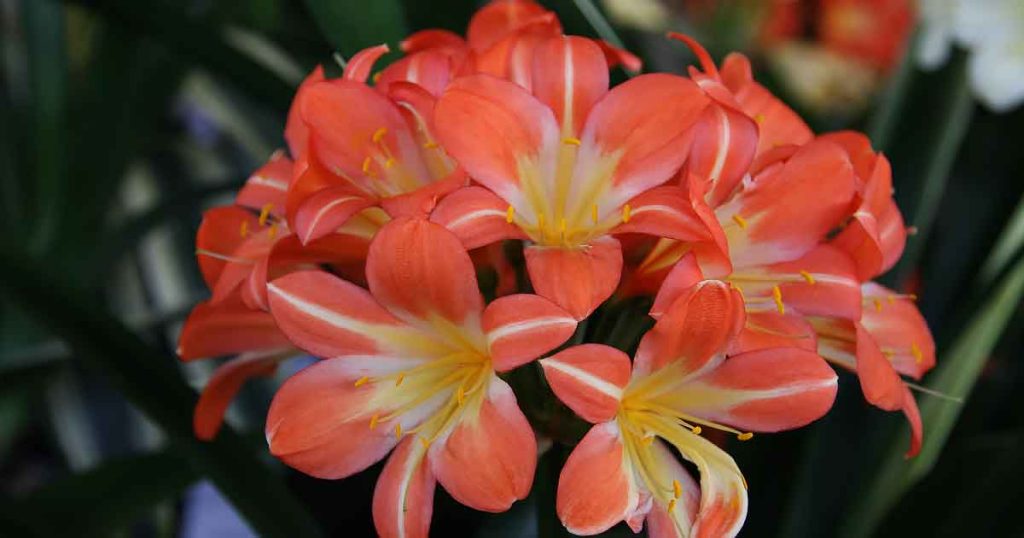
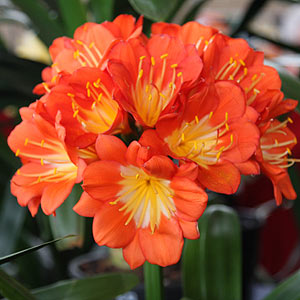
Over recent years the yellow flowering Clivia miniata has become very popular, a change from the traditional orange. However you can find a lot more in terms of variety from specialist clivia breeders including multi colored flowers and different flower forms
The very popular Clivia miniata (picture right) are some of the most popular indoor plants available for sale and are perhaps one of the best shade plants for dry conditions.
Although these wonderful plants are sometimes called the Clivia Lily, they are not lilies at all.
Growers specialize in both species and hybrids with some fascinating forms and color combinations available they offer both clivia plants and seeds for sale and can readily supply plants such as Yellow clivia which are increasingly popular in the US.
Clivia miniata are just one of the popular species along with Clivia nobilis and with the flowers being long lasting, they do look great in the shade garden.
Care
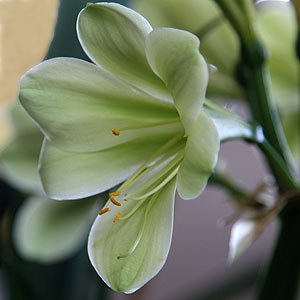
One of the great shade loving plants, Clivia miniata have low water requirement, glossy green foliage and Clivia flowers are an asset to any garden.
This low light low water make them an excellent plant for indoors, hence the popularity in different USDA Zones including California where you can grow them outdoors in the garden in coastal areas, New York (strictly indoors in winter), and Florida where they are fairly happy outdoors all year round.
Clivia do not like to be planted in heavy soil, many growers use an aerated potting mixture such as perlite or composted pine bark mulch. In the ground, again they need good drainage. Look out for for Clivia Robusta, a giant clivia.
Problems
How to save Clivia with Root Rot or no roots
How to Grow Clivia miniata
Like all Clivia varieties this is plant that is easy care in a warm climate and a well drained soil. They do not survive heavy frosts and freezes and do not like direct sun
- Light
Choose a position in dappled shade or filtered light, indoors keep away from sun coming directly through windows. - Soil
A humus rich free draining soil or potting mix is essential. In containers make sure the pot has adequate drainage holes. In heavy soils add some extra drainage materials such as perlite, scoria or other rock. - Temperature
This is a plant that grows best between 60–77F (15-25 C). They will survive lower temperatures but may suffer foliage damage. In cold and wet conditions they will struggle to survive. In higher temperatures that will survive if provided with adequate shade and sone extra water.
For good flowering, Clivia do require lower temperatures during winter, this promotes bud development. - Watering
Water only when the soil begins to dry, hold back on watering during winter, and again immediately after flowering.
Potting Clivia
In many zones it is just to cold to grow Clivia outdoors, so potted plants are the answer.
It is best to keep Clivia in small pots, over-potting clivia tends to lead to an over supply of water and this can lead to the roots rotting.
So keep clivia in smallish pots and only pot up to larger pots when needed.
Remember to use a free draining potting mix.
Fertilizing Clivia
A slow release fertilizer is often thought to be the best for clivia, although many growers also use liquid fertilizers such as seaweed fertilizers, once a week during the spring to summer period when clivia are growing.
Some growers do add Iron Chelates to help promote photosynthesis, however less is is better than more in this case.
Although these plants will grow well outdoors, and are particularly popular in California, they are are also high on the list of indoor plants for Massachusetts and Connecticut where they are container grown and overwintered in a protected position.
In colder zones they can be put outside during the summer and brought inside well before the first frosts.
Varieties
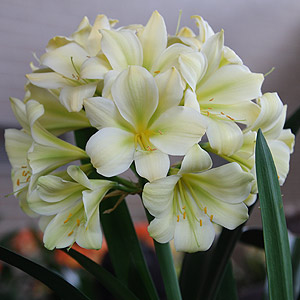
In terms of varieties, within the Clivia miniata group of hybrids the types are endless. The amazing Clivia miniata ‘Striped petal’ pictured right, is just the beginning. so many pastel hybrids, multi petal and broad leaf forms that it is difficult to list.
In terms of Clivia miniata hybrids we have :
- Variegated foliage – Green foliage with yellow to white bands.
- Multi-petal and Striped Petals
- Keeled Petal – Flowers that have a ruffled appearance.
- Tulip Shaped – Flowers that are tulip, or bud shaped.
- Then we have the Clivia species :
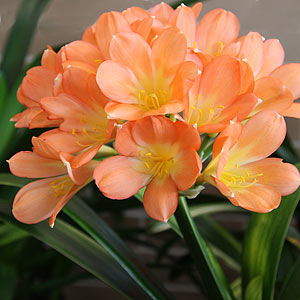
Clivia species are the six from which all of the modern hybrids, including Interspecific hybrids and Belgian hybrids have been developed and are :
- Clivia gardenii
- Clivia caulescens
- Clivia miniata
- Clivia mirabilis
- Clivia nobilis
- Clivia robusta
Renowned hybridizers including Dr. Hirao, Mr. Nakamura and Toshiyuki Hosoya (Toshi) have been responsible for many exciting and new cultivars that have been developed in Japan. These include Akebomo, Multi petal, Variegated, Green (Hirao), Daruma, Fukurin, Broadleaf and Short leaf forms of clivia.
Breeders in South Africa, Belgium, China, Australia and the USA are also producing a fascinating range of clivia including new colors and improved flowers and leaf forms.
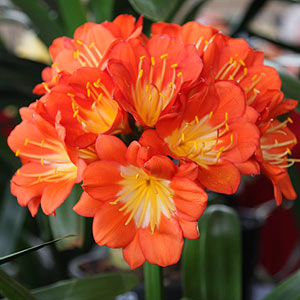
Propagation
Usually from seed which can be surface sown in mid spring. Ensure that the seeds get cold night time temperatures during the germination period.
Plants will take around 6 years to flower from seed. Viable seed will need be found, and hand pollination is often used to ensure seed set.
Clivia are also propagated by division, much easier than by seed. Established clumps can be divided just after flowering.
No need to cut the foliage back, just divide, re-pot and water in.
Growing Clivia Indoors
Why are Clivia so Popular as indoor plants ?
Firstly they have great flowers and good foliage. However it is the their growing requirements that make so suitable for indoors.
- Dry soil.
- Dry Air.
- Good strong filtered light.
- They also thrive on neglect, they like to be pot-bound.
Summary
- Botanical Name : Clivia miniata
- Common Names : Kaffir Lily, Natal Lily.
- Origins : Souther South Africa
- Position : Filtered Light or Dappled Shade
- USDA Zones : 9 – 11a outdoors
- Soil : Well drained
- Height : To around 2ft
- Spread : To around 2ft
- Growth Rate : Slow to Medium
- Flower Colour : Large Yellow to Orange with many colourful hybrids.
- Flowering Time : Winter to Spring
- Foliage : Green strap like
Where to Buy
SHIELDS GARDEN
P.O. Box 92 Westfield, In 46074 U.S.A. PH – 317-867-3344
CLIVIA USA
8 Ocean View Road Swampscott, Ma 01907 – sales@cliviausa.com
We offer both plant and seeds of rare and hard to find clivia species. Hirao Crosses, Appleblossoms, Etc.

